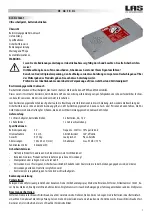
10
Charging and Activation Logics
charge current would turn into heat or gas. Because of this, the charge controller will reduce the
voltage charge to smaller quantity, while lightly charging the battery. The purpose for this is to
offset the power consumption while maintaining a full battery storage capacity. In the event that
a load drawn from the battery exceeds the charge current, the controller will no longer be able
to maintain the battery to a Float set point and the controller will end the float charge stage and
refer back to bulk charging.
z
Equalization:
Equalization is carried out every 30 days of the month. It is intentional overcharging of the
battery for a controlled period of time. Certain types of batteries benefit from periodic equalizing
charge, which can stir the electrolyte, balance battery voltage and complete chemical reaction.
Equalization charging increases the battery voltage, higher than the standard complement
voltage, which gasifies the battery electrolyte.
CAUTION
z
It is recommended to use only non-sealed/vented/flooded/wet cell lead acid batteries in the
Equalization stage.
z
Do not equalize VRLA type AGM/gel/lithium cell batteries unless permitted by battery
manufacturer.
WARNING
z
Once Equalization is active in the battery charging, the charge controller will not exit this
stage unless there is a sufficient source of charging current from the solar panel. There
should be NO load on the batteries when in equalization charging.
z
Overcharging and excessive gas precipitation may damage the battery plates and activate
material shedding on them. Too high of an Equalization charging or too long of one may
cause damage. Review the specific requirements of the battery used in the system carefully.
z
Equalization may increase battery voltage to a level that damages to sensitive DC loads.
Ensure that allowable input voltages of all loads are greater than the set voltage during
Equalization charging.
MPPT Technology
Four Charging Stages
Lithium Battery Activation











































